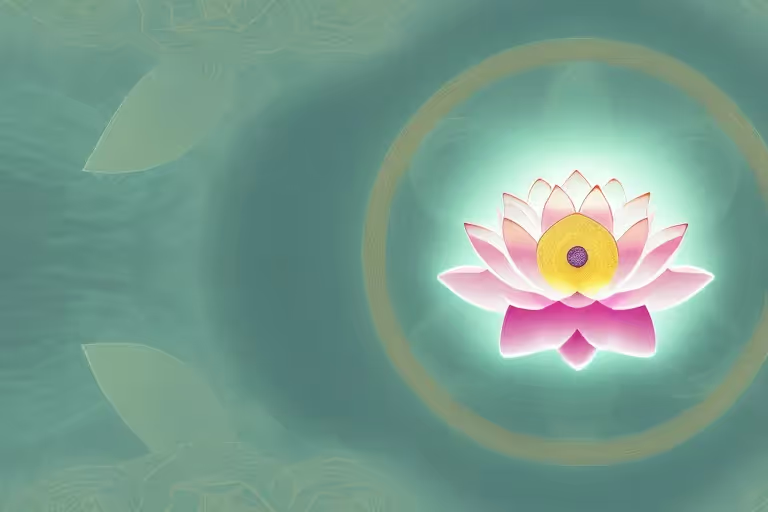In the quiet spaces of our mind, we find moments of respite from the chaos of the outside world. An ancient practice beckons us, promising tranquility and clarity— this profound method is meditation. But what if we could amplify the power of our meditations and connect even deeper with ourselves? The key lies in an essential element known as Mudras.
Understanding the Basics of Meditation
Meditation has long been embraced by various cultures around the globe. To many, it signifies a journey inward; a quest for peace, personal enlightenment, and a desire to make meaningful connections with the universe. The transformative potential of meditation is immense, yet often, it can feel elusive and complex to beginners.
Demystifying this powerful practice starts with understanding its basics. So, let's commence our journey into the world of meditation by traveling back into history.
The History and Importance of Meditation
Historians believe that meditation's roots can be traced back to as early as 5000 to 3500 BC. Evolving independently in various parts of the world; India, China, and even the prehistoric Shamanistic traditions of Europe and North America embraced its power.
In India, meditation was an integral part of the ancient yogic tradition. Yogis would retreat to secluded caves, forests, and mountains to practice meditation as a means to attain spiritual enlightenment. The teachings and practices of these early yogis laid the foundation for the diverse array of meditation techniques we have today.
In China, Taoist monks developed their own unique styles of meditation, focusing on cultivating internal energy and harmonizing the body, mind, and spirit. These practices became an integral part of Taoist philosophy and influenced other forms of meditation in East Asia.
Even in the prehistoric Shamanistic traditions of Europe and North America, meditation played a significant role. Shamans would enter altered states of consciousness through meditation to connect with the spiritual realm, seek guidance, and heal the community.
Fast forward to the present, the importance of meditation has never been more evident. We live in a world dominated by information overload and constant distractions. Regular meditation can help us regain our mental equilibrium, calming our turbulent minds and soothing our weary souls.
Scientific studies have shown that meditation has numerous benefits for our physical, mental, and emotional well-being. It can reduce stress, improve focus and concentration, enhance creativity, boost immune function, and promote overall happiness and well-being.
Aura has the world’s largest and best collection of Meditations and hundreds of Coaches to choose from.
Try it Free!
Different Types of Meditation Techniques
Over the millennia, an impressive variety of meditation techniques have been developed. Some notable methods include mindfulness meditation, transcendental meditation, and loving-kindness meditation.
Mindfulness meditation, derived from Buddhist traditions, involves bringing one's attention to the present moment, observing thoughts and sensations without judgment. It cultivates a sense of awareness and acceptance, allowing us to develop a deeper understanding of ourselves and the world around us.
Transcendental meditation, popularized by Maharishi Mahesh Yogi in the 1950s, involves the use of a mantra - a specific word or sound - to focus the mind and transcend ordinary thinking. It aims to achieve a state of deep relaxation and expanded awareness.
Loving-kindness meditation, also known as Metta meditation, involves cultivating feelings of love, compassion, and goodwill towards oneself and others. It helps develop empathy, reduce negative emotions, and foster a sense of interconnectedness and kindness.
While each technique has its unique characteristics and goals, they all share a common purpose - to guide the practitioner towards a state of heightened awareness and deep peace. Exploring different techniques can help individuals find the approach that resonates most with them and supports their personal growth and well-being.
The Role of Mudras in Meditation
Understanding the power of Mudras can be transformative for both novice and experienced meditators. These ancient symbols serve as an opportunity to deepen our meditation practice and unlock latent potential within ourselves.
As we delve into the world of Mudras, it is essential to understand their origins and significance. Mudras, derived from the Sanskrit word for 'seal', are intricate hand gestures that have been employed in various Eastern practices, like yoga and meditation, for centuries.
The art of Mudras involves aligning our fingers in specific configurations, each holding its unique symbolism and purpose. These hand gestures are not merely symbolic but are believed to create energy circuits within our body, influencing our mind and facilitating profound internal shifts.
What are Mudras?
At first glance, Mudras may seem like simple hand movements, but their significance runs much deeper. Each Mudra has a specific meaning and intention behind it, making it an integral part of the meditation practice.
For instance, the Gyan Mudra, formed by touching the tip of the thumb to the tip of the index finger, symbolizes wisdom and knowledge. This Mudra is believed to enhance concentration and memory, making it a popular choice for those seeking mental clarity during meditation.
Another well-known Mudra is the Anjali Mudra, commonly seen in prayer or greeting gestures. This Mudra represents gratitude and unity, reminding us of the interconnectedness of all beings and fostering a sense of harmony within ourselves.
The Connection between Mudras and Meditation
Meditation and Mudras are deeply intertwined, complementing each other in profound ways. In practical terms, Mudras help meditators maintain focus, reducing the likelihood of the mind wandering during sessions. They serve as an anchor, a point of continuous return during the ebb and flow of thoughts.
However, the benefits of Mudras extend beyond concentration. These hand gestures enable the free flow of energy within the body, amplifying the effects of meditation and allowing for a deeper connection with ourselves.
When we engage in Mudras during meditation, we activate specific energy channels, known as nadis, within our body. These nadis are said to carry life force energy, known as prana, throughout our being. By manipulating the flow of prana through Mudras, we can direct and balance this vital energy, promoting physical, mental, and spiritual well-being.
Furthermore, Mudras can also stimulate specific areas of the brain, enhancing our cognitive abilities and emotional well-being. Scientific studies have shown that certain Mudras can activate regions of the brain associated with relaxation, focus, and emotional stability, leading to a more profound and fulfilling meditation experience.
As we explore the world of Mudras, it becomes apparent that these hand gestures hold immense potential for personal growth and transformation. Whether we are seeking to calm the mind, cultivate inner peace, or tap into our innate wisdom, incorporating Mudras into our meditation practice can be a powerful tool on our spiritual journey.
Exploring Different Types of Mudras
With hundreds of Mudras, each unique and linked to different aspects of our wellbeing, the exploration of these ancient hand gestures is a fascinating journey.
As we delve deeper into the world of Mudras, we discover a multitude of hand gestures that can enhance various aspects of our lives. These gestures have been practiced for centuries and are believed to have profound effects on our physical, mental, and spiritual well-being.
Gyan Mudra for Enhancing Knowledge
Recognized as the 'mudra of knowledge', the Gyan Mudra involves connecting the tip of the thumb and the tip of the index finger. This simple gesture is believed to stimulate the root chakra, enhancing mental clarity and comprehension.
When practicing the Gyan Mudra, one can experience a sense of focus and concentration. It is said to activate the brain cells, improving memory and concentration. This mudra is often used during study sessions or when seeking knowledge and wisdom.
Prana Mudra for Boosting Life Force
The Prana Mudra is often referred to as the 'mudra of life'. By touching the tips of the thumb, ring finger, and little finger together, you stimulate the flow of vitality throughout your body.
When performed regularly, the Prana Mudra is believed to increase the life force energy within us. It is said to boost our immune system, improve our overall health, and enhance our vitality. This mudra is particularly beneficial for those who feel drained or fatigued, as it helps replenish and revitalize the energy levels.
Dhyana Mudra for Deep Meditation
For a deeper meditative experience, the Dhyana Mudra is an ideal choice. By placing the right hand on top of the left with the thumbs touching, one can encourage the mind to turn inwards, promoting clarity, tranquility, and unity of thought.
When practicing the Dhyana Mudra, one can experience a sense of calmness and serenity. It is believed to help quiet the mind, allowing us to enter a state of deep relaxation and meditation. This mudra is often used by those seeking inner peace and spiritual growth.
As we continue our exploration of Mudras, we uncover even more fascinating hand gestures that can bring balance and harmony to our lives. Each Mudra holds its own unique benefits and significance, making the journey of discovering and practicing them an enriching and transformative experience.
How to Incorporate Mudras into Your Meditation Practice
It is often said that the crest of a wave reflects the depth of the ocean. Similarly, the success of incorporating Mudras into your meditation practice is fundamentally about aligning your intent with your actions.
Mudras, hand gestures or seals, have been used for centuries in various spiritual and healing traditions to enhance focus, channel energy, and deepen the meditative experience. By incorporating Mudras into your meditation practice, you can tap into the power of these ancient symbols and unlock new dimensions of mindfulness.
Choosing the Right Mudra for Your Needs
Begin by understanding the significance of each Mudra. Reflect on your current state of being and what you wish to cultivate. If you seek wisdom, perhaps the Gyan Mudra is your key; for energy, try the Prana Mudra.
The Gyan Mudra, also known as the wisdom seal, is formed by touching the tip of the thumb to the tip of the index finger, creating a circular shape. This Mudra enhances concentration, memory, and promotes mental clarity. By practicing this Mudra during meditation, you can invite a deeper understanding and connection with the wisdom within.
The Prana Mudra, on the other hand, is formed by touching the tip of the thumb to the tips of the ring finger and little finger, while keeping the other fingers extended. This Mudra is believed to increase vitality, invigorate the body, and balance the energy flow. By incorporating the Prana Mudra into your meditation practice, you can tap into a renewed sense of energy and life force.
Steps to Perform Mudras Correctly
Incorporating Mudras into your practice involves technique and consistency. Familiarize yourself with the specific positions and maintain them throughout your meditation session. Remember, practice makes perfect.
Start by finding a comfortable seated position, with your spine straight and your hands resting on your thighs. Take a few deep breaths to center yourself and bring your awareness to the present moment.
When you are ready, bring your hands into the chosen Mudra, gently touching the fingertips together as instructed. Allow your hands to rest comfortably on your lap or thighs, without any tension or strain.
As you continue with your meditation, keep your focus on your breath or any other chosen point of concentration. Feel the energy flowing through your Mudra, connecting you to the intention you have set for your practice.
It is important to note that the effects of Mudras may vary from person to person. It may take time and consistent practice to fully experience the benefits of incorporating Mudras into your meditation practice. Be patient with yourself and trust the process.
As you deepen your understanding and practice of Mudras, you may explore different combinations of hand gestures to enhance specific qualities or address specific needs. The possibilities are endless, and the journey of self-discovery through Mudras is a continuous one.
The Benefits of Combining Mudras with Meditation
The union of Mudras and meditation is a powerful combination, unravelling myriad benefits for the human body, mind, and spirit.
Physical and Mental Health Benefits
Your physical wellness is inherently intertwined with your mental well-being. Regularly practising meditation with Mudras can lead to improved immunity, reduced anxiety, better concentration, and a healthier heart. It's an all-encompassing natural remedy for various ailments.
Spiritual Growth and Enlightenment
At a spiritual level, Mudras help to create a conducive environment for exploring higher states of consciousness, fostering a sense of interconnectedness with the universe, accelerating spiritual growth, and paving the way to self-realization and enlightenment.
In the quest for enhanced mindfulness, the Aura Health app offers a massive library of guided meditations and relaxing sounds, allowing you to cultivate positivity and achieve peace with ease. It’s more than just an app; it’s your personal mindfulness companion.
Aura is Your All In One App for Meditation, Mindfulness Wellbeing
Find peace every day with one app for your whole well-being. There is no one-size-fits-all solution to mental well-being. Aura is the first all-in-one wellness app that learns how to best help you. Discover an endless library of expert-created tracks for your well-being, all taught by the world’s best coaches, therapists, and storytellers. With Aura's personalized recommendations, you can find peace every morning, day and night.



.webp)






.avif)

%20(1).avif)


.avif)
.avif)
.webp)


.avif)


















































































































.avif)

















.svg)









